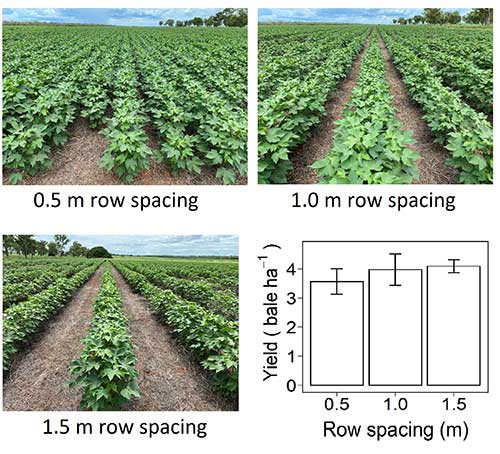Choosing a row spacing configuration for rainfed cotton in the Northern Territory
The Northern Territory has great potential as a cotton production region, but faces a number of different challenges from those in traditional temperate growing regions, due to highly variable rainfall, high soil evaporation rates and low soil moisture reserves.
Rainfed cotton planted in mid-December to mid-January requires adequate soil moisture to be available following the cessation of the monsoon rains in April-May to fill bolls. Optimising the use of available soil moisture throughout the season is important in producing an economically viable cotton crop in this region.
Row spacing configuration plays an important role in crop development and resource use. Narrower row spacing may lead to earlier canopy closure and maturity, therefore, reduced soil evaporation and water stress, while wider row spacing provides less competition for soil moisture reserves therefore more per plant yield. The challenge is to identify the right trade-off and the adaptability of existing equipment to alternative row spacing configurations. Therefore, to identify the optimal row spacing configuration for rainfed cotton, and to assess the adaptability of harvesting equipment, a replicated trial was conducted comparing 0.5m, 1.0m and 1.5m row spacing on a sandy clay loam soil in 2021, in close collaboration with CSIRO.
Crops at 0.5m row spacing reached 60% open boll 2 weeks earlier than the conventional 1m rows, which could be an advantage in seasons when the wet season ends earlier than it did in 2021 or when later planting is required. Although the yield was not statistically lower, within field variability was much higher suggesting refinements in crop management are required. While crops at 1.5m row spacing reached 60% open boll a week later than the conventional 1m rows but produced a similar yield. Due to earlier canopy closure, the 0.5m rows required fewer in crop herbicide treatments than 1m rows; the 1.5m rows required the most treatments.
A strong influence on the adoption of any alternative row spacing is the availability of suitable harvesting equipment and planting equipment. The row spacing configurations used here were limited by the capacity of the available planting equipment but provided a good guide to the impact of rows wider and narrower than the traditional 1m on crop maturity and yield.
Investment in alternative equipment is expensive, and as such any alternative row spacing would need to produce a clear economic benefit for it to be adopted widely. This benefit however was not evident on this soil in the 2021 season.
Further experimentation is required to confirm and expand on these results.

Acknowledgement
Funding for this research was provided by the Cooperative Research Centre for Developing Northern Australia (CRCNA) through the project Potential for broadacre cropping in the NT.
Collaborators
CSIRO: Stephen Yeates and Tiemen Rhebergen
Department of Industry, Tourism and Trade: Peter Shotton, Nick Hartley Cameron David Crawford, Alex Peachey and Matt Hall.
